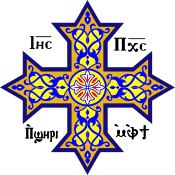| Part of a series on the |
| Copts |
|---|
| Culture |
| Regions |
| Denominations |
|
|
Coptic music is the music sung and played in the Coptic Orthodox Church (Church of Egypt) and the Coptic Catholic Church. It consists mainly of chanted hymns in rhythm with instruments such as cymbals (hand and large size) and the triangle. Coptic music is purely religious.
Coptic chant is a very old tradition, assumed to have links with the ancient liturgies of Jerusalem or Syria, however, manuscripts survive only since recent times and little is known for sure about the older tradition. Until these recent liturgical books, the music was transmitted orally. In the modern chant, there is extensive use of melody types, which allow some improvisation by the singers.
The percussion instruments used in the Coptic Church are unusual among Christian liturgies. Since similar instruments appear in ancient Egyptian frescoes and reliefs, some believe that they may represent a survival from a very old tradition.
The most famous modern Coptic cantor is the late Cantor Mikhail Girgis El Batanouny, whose recordings have helped preserve and unify many ancient chants that otherwise would have been lost, however, they were recorded in Greco-Bohairic Pronunciation.
Contemporary personalities contributing to Coptic music[edit]
- Mikhail Girgis El Batanouny
- Adel Kamel
- Ragheb Moftah
- Ernest Newlandsmith
- Nabila Erian
- Emmanuel Saad
- Abanob Ghobrial[1]
See also[edit]
References[edit]
- ^ "أبانوب غبريال.. عندما يكون شغف المغني إحياء لغتنا القبطية (حوار)". elmeezan.com (in Arabic). Retrieved 2020-06-30.
External links[edit]
- "The Transmission of Coptic Orthodox Liturgical Music: Historical and Contemporary Forms of Theorization, Translation, and Identity Construction" A PhD dissertation exploring the history and current practice and theory of Coptic music.
- "Coptic youth blog" Contains digital music and videos of Coptic liturgies, hymns, songs, and Coptic hymn lessons.
- "Coptic Music," Claremont Coptic Encyclopedia
- Complete collection of Cantor Mikhail Girgis El Batanouny's recordings of Coptic chant from coptichymns.net
- DeaconTube - A video learning website for Coptic Orthodox hymns
- coptichymns.net coptichymns.net - Sharing the Joy of Coptic Hymns Around the World
- copticheritage.org The Official Website of the Heritage of the Coptic Orthodox Church.
- Coptic Music, Hymns, and Rites Articles from coptichymns.net
- Coptic Music Articles
- Coptic Multimedia Archive at Saint TeklaHimanot Church of Egypt Articles
- Coptic Orthodox Liturgical Chant & Hymnody and the Ragheb Moftah Collection at the Library of Congress

Well, that’s interesting to know that Psilotum nudum are known as whisk ferns. Psilotum nudum is the commoner species of the two. While the P. flaccidum is a rare species and is found in the tropical islands. Both the species are usually epiphytic in habit and grow upon tree ferns. These species may also be terrestrial and grow in humus or in the crevices of the rocks.
View the detailed Guide of Psilotum nudum: Detailed Study Of Psilotum Nudum (Whisk Fern), Classification, Anatomy, Reproduction